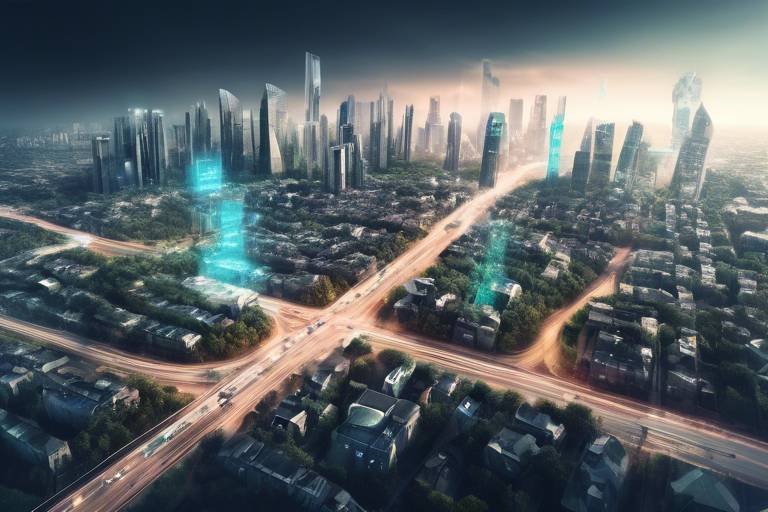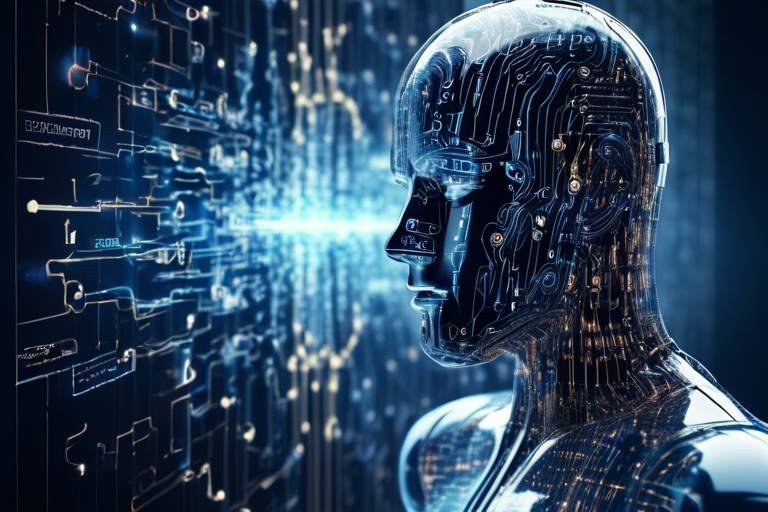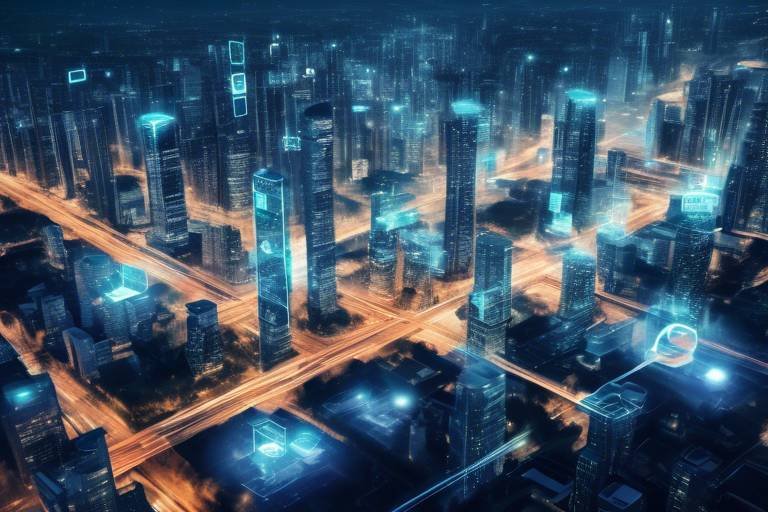Artificial Intelligence in Clean Energy: A Renewable Revolution?
In recent years, the intersection of artificial intelligence (AI) and clean energy has sparked a wave of innovative solutions that promise to transform the way we produce, manage, and consume energy. Imagine a world where energy systems are not just reactive but proactive, adjusting in real time to meet the demands of users while minimizing waste. This is the potential that AI holds in the clean energy sector—a true renewable revolution that could reshape our approach to sustainability. As we delve deeper into this topic, we will explore how AI is enhancing efficiency, reducing costs, and accelerating the transition to renewable energy sources.
To grasp the impact of AI on clean energy, we first need to understand what AI is and how it functions within this sector. At its core, AI refers to systems that can perform tasks that typically require human intelligence, such as learning, reasoning, and problem-solving. In clean energy, AI applications range from optimizing energy production to managing consumption patterns. For instance, AI algorithms can analyze vast amounts of data from renewable energy sources like solar panels and wind turbines to predict energy output, thereby enhancing the reliability of these systems. This not only increases the efficiency of energy production but also plays a crucial role in integrating renewable sources into the existing energy grid.
The integration of AI technologies into clean energy systems brings a plethora of advantages that can significantly improve overall performance. One of the most notable benefits is enhanced energy management. AI systems can analyze real-time data to optimize energy usage, balancing supply and demand effectively. This not only reduces waste but also lowers operational costs, making renewable energy sources more competitive against traditional fossil fuels. Furthermore, AI facilitates predictive maintenance, allowing operators to foresee equipment failures before they occur, thus saving both time and money. Imagine being able to predict when a wind turbine might fail and addressing the issue before it leads to costly downtime—that's the power of AI in action.
AI-powered energy management systems are revolutionizing the way we utilize energy. These systems utilize complex algorithms to monitor energy consumption patterns, allowing for a more efficient distribution of resources. By analyzing historical data and current usage, AI can recommend optimal energy usage strategies, which can lead to significant cost savings for both consumers and providers. For example, during periods of low demand, these systems can automatically adjust energy output from renewable sources, preventing excess energy production and reducing waste.
One of the most exciting developments in clean energy is the advent of smart grids. These grids leverage AI to enhance the management of energy distribution, ensuring that energy is delivered where it is needed most. Smart grids can dynamically adjust to fluctuations in energy demand and supply, incorporating various renewable sources seamlessly. This technology not only improves efficiency but also increases the reliability of energy systems, making them more resilient to outages and disruptions. With smart grids, we are moving towards a future where energy is not just consumed but intelligently managed.
Another vital application of AI in clean energy is the development of demand response solutions. These systems empower consumers to adjust their energy usage during peak demand periods, effectively contributing to grid stability. By incentivizing users to reduce consumption during high-demand times, AI-driven demand response solutions help prevent blackouts and promote energy conservation. This is particularly important in a world where energy consumption is continuously rising. By making small adjustments to their usage habits, consumers can play a significant role in the larger energy ecosystem.
Predictive maintenance is another area where AI shines in the clean energy sector. By analyzing data from various sensors and monitoring systems, AI can predict when equipment is likely to fail, allowing for timely interventions. This proactive approach not only minimizes downtime but also extends the lifespan of renewable energy installations. For instance, in solar farms, AI can monitor the performance of individual panels and identify those that are underperforming. By addressing these issues early, operators can ensure maximum efficiency and output from their renewable energy investments.
While the benefits of AI in clean energy are substantial, it’s crucial to acknowledge the challenges and limitations that accompany its implementation. From data privacy concerns to high initial costs, these hurdles can impede the widespread adoption of AI technologies in the sector. Understanding these challenges is vital for stakeholders looking to navigate the evolving landscape of clean energy.
The use of AI in energy management raises significant concerns about data privacy and security. As energy systems become increasingly interconnected, the amount of data collected from consumers and equipment grows exponentially. This data, if not handled properly, can lead to privacy breaches and misuse. It is essential for companies to implement robust data handling practices to protect sensitive information while still leveraging the benefits of AI.
Another significant barrier to the adoption of AI in clean energy is the high implementation costs. The initial investment required to integrate AI technologies can be daunting for many companies, particularly smaller firms. However, it is essential to view this as a long-term investment that can yield substantial savings and efficiency gains over time. As the technology matures and becomes more accessible, it is likely that these costs will decrease, making AI solutions more attainable for a broader range of energy providers.
Looking ahead, the future of AI in the clean energy sector appears bright. As technology continues to advance, we can expect significant improvements in the efficiency and reliability of renewable energy systems. Policymakers and investors play a crucial role in shaping this evolution, as supportive regulations and funding can accelerate the adoption of AI technologies. By fostering an environment that encourages innovation, we can unlock the full potential of AI in creating a sustainable energy future.
- What is the role of AI in renewable energy? AI enhances efficiency, optimizes energy management, predicts equipment failures, and facilitates better decision-making in the clean energy sector.
- How do smart grids work? Smart grids use AI to monitor and manage energy distribution, adjusting in real time to meet demand and ensure reliability.
- What are demand response solutions? These are AI-driven systems that help consumers adjust their energy usage during peak times, promoting grid stability and energy conservation.
- What are the challenges of implementing AI in clean energy? Major challenges include data privacy concerns and high initial implementation costs.
- What does the future hold for AI in clean energy? The future looks promising, with expected advancements in technology and supportive policies driving the adoption of AI solutions.

Understanding AI in Clean Energy
Artificial Intelligence (AI) is more than just a buzzword; it's a game-changer in the clean energy sector. But what exactly is AI? In simple terms, AI refers to the capability of a machine to imitate intelligent human behavior. It involves algorithms and data analytics that allow systems to learn from experience, adapt to new inputs, and perform tasks that typically require human intelligence. In the context of clean energy, AI is reshaping how we generate, distribute, and consume energy, making processes more efficient and sustainable.
Imagine a world where your energy consumption is optimized without you lifting a finger. That’s the promise of AI in clean energy! Whether it’s through smart grids that adjust energy flow in real-time or predictive maintenance systems that alert you before your solar panels fail, AI is revolutionizing the landscape. It helps in analyzing vast amounts of data from renewable energy sources, weather patterns, and consumption trends, allowing for smarter decisions that lead to reduced costs and enhanced efficiency.
One of the most exciting aspects of AI in clean energy is its ability to integrate with various technologies. For instance, AI can enhance energy management systems by predicting demand and adjusting supply accordingly. This not only helps in minimizing energy waste but also ensures that renewable energy sources are utilized to their fullest potential. Let’s break down some key applications of AI in this sector:
- Smart Grids: These are advanced electrical grids that use AI to monitor and manage the distribution of energy, ensuring reliability and efficiency.
- Demand Response Solutions: AI-driven systems that help consumers adjust their energy usage during peak times, thus stabilizing the grid.
- Predictive Maintenance: AI algorithms can foresee equipment failures before they happen, significantly reducing downtime and maintenance costs.
By harnessing these technologies, we can not only improve the performance of renewable energy systems but also contribute to a more sustainable future. The integration of AI allows for a more dynamic response to energy needs, promoting a balance between supply and demand. This is crucial as we move towards a future that increasingly relies on renewable sources like wind, solar, and hydroelectric power.
However, it’s essential to recognize that while AI offers significant advantages, its implementation also comes with challenges. As we delve deeper into the world of AI in clean energy, we must consider the implications of data handling, the costs of technology adoption, and the overall impact on society. Understanding these factors is vital for stakeholders in the clean energy sector to make informed decisions and drive the renewable revolution forward.

Benefits of AI Integration
Integrating artificial intelligence (AI) into the clean energy sector is not just a trend; it's a game-changer that can redefine how we produce, manage, and consume energy. Imagine a world where energy systems are not only efficient but also smart enough to predict and adapt to our needs. This is the promise of AI in clean energy. With its ability to analyze vast amounts of data and learn from it, AI offers a multitude of benefits that can lead to a more sustainable and cost-effective energy future.
One of the most significant advantages of AI integration is improved energy management. AI systems can process real-time data from various sources, allowing for a more precise balance between energy supply and demand. This means that energy providers can optimize production schedules, reducing waste and lowering costs. For instance, AI algorithms can analyze weather patterns to predict solar energy production, enabling better planning for energy distribution. A well-optimized energy management system can lead to substantial cost savings, which can be passed on to consumers.
Additionally, AI enhances predictive maintenance, which is crucial for renewable energy installations. By continuously monitoring equipment performance and analyzing historical data, AI can predict when a piece of equipment is likely to fail. This foresight allows companies to perform maintenance before a failure occurs, minimizing downtime and repair costs. For example, a wind turbine equipped with AI technology can alert operators to potential issues, ensuring that the turbine remains operational and continues to generate energy efficiently.
Another remarkable benefit of AI in clean energy is its role in enhanced decision-making capabilities. With the vast amount of data generated by energy systems, making informed decisions can be overwhelming. Here, AI steps in as a powerful ally. It can sift through complex datasets, identify patterns, and provide actionable insights. This capability is invaluable for energy companies looking to make strategic decisions about investments, resource allocation, and operational efficiency. By leveraging AI, companies can make decisions that are not only data-driven but also forward-thinking, paving the way for innovation in the energy sector.
Furthermore, AI plays a crucial role in developing smart grids. These advanced energy systems utilize AI to monitor and manage electricity distribution in real-time, ensuring that energy flows where it is needed most. Smart grids can automatically adjust to fluctuations in energy supply and demand, facilitating the integration of renewable sources like solar and wind. This flexibility is vital for creating a resilient energy infrastructure that can withstand the challenges posed by climate change and increasing energy consumption.
Moreover, AI-driven demand response solutions are transforming how consumers interact with energy systems. These solutions empower users to adjust their energy consumption during peak demand times, which not only helps stabilize the grid but also encourages energy conservation. For instance, during peak hours, AI can send notifications to consumers, suggesting they shift their energy usage to off-peak times, thus reducing strain on the grid and lowering energy bills.
In summary, the benefits of integrating AI into clean energy systems are profound and far-reaching. From optimizing energy management and predictive maintenance to enhancing decision-making and enabling smart grids, AI is revolutionizing the energy landscape. As we continue to embrace these technologies, we can look forward to a future that is not only more efficient but also more sustainable.
- What is AI's role in clean energy management? AI helps optimize energy usage by analyzing data and predicting energy demand, leading to more efficient energy distribution and reduced costs.
- How does AI contribute to predictive maintenance? AI monitors equipment performance and uses historical data to predict failures, allowing for timely maintenance and minimizing downtime.
- What are smart grids? Smart grids utilize AI to manage electricity distribution in real-time, ensuring efficient energy flow and integrating renewable sources effectively.
- Can AI help consumers save on energy costs? Yes, AI-driven demand response solutions encourage consumers to adjust their energy usage during peak times, leading to lower energy bills.

Energy Management Systems
Energy management systems (EMS) powered by artificial intelligence are revolutionizing how we consume and manage energy. Imagine a world where your energy usage is finely tuned to match the needs of your home or business, all while minimizing waste and slashing costs. Sounds futuristic, right? Well, that future is now! AI-driven EMS can analyze vast amounts of data in real-time, allowing them to optimize energy consumption based on current demand and supply conditions.
These systems work by collecting data from various sources, such as smart meters, weather forecasts, and energy consumption patterns. With this information, AI algorithms can predict energy usage trends and adjust settings accordingly. For instance, if the system detects that energy demand is peaking, it can automatically adjust heating or cooling settings to reduce consumption. This not only enhances efficiency but also contributes to a more sustainable energy future.
Moreover, the integration of AI into EMS facilitates better decision-making for both consumers and energy providers. It provides insights that were previously unattainable, enabling users to make informed choices about their energy consumption. By leveraging machine learning, these systems can continuously improve their performance over time, learning from past data to refine their predictions and recommendations.
To illustrate the impact of AI in energy management, consider the following key benefits:
- Real-time Monitoring: Continuous tracking of energy usage helps identify inefficiencies.
- Cost Savings: By optimizing energy consumption, users can significantly reduce their energy bills.
- Environmental Impact: Reduced energy waste leads to lower carbon emissions, contributing to a healthier planet.
In summary, AI-powered energy management systems are not just about cutting costs; they represent a paradigm shift towards a more intelligent and responsive energy landscape. As we continue to embrace renewable energy sources, these systems will play a crucial role in ensuring that energy is used wisely and sustainably.
- What is an Energy Management System?
An Energy Management System (EMS) is a technology that helps monitor, control, and optimize energy use in buildings or facilities.
- How does AI enhance Energy Management Systems?
AI enhances EMS by analyzing data in real-time to optimize energy consumption, predict usage patterns, and improve decision-making.
- What are the benefits of using AI in energy management?
Benefits include cost savings, improved efficiency, real-time monitoring, and a reduced environmental impact.
- Are there any challenges associated with AI in energy management?
Yes, challenges include data privacy concerns and high implementation costs.

Smart Grids
Smart grids represent a revolutionary leap in how we manage and distribute energy. Imagine a network that is not just a passive conduit for electricity, but an intelligent system that actively monitors and manages energy flow. This is exactly what smart grids do, harnessing the power of artificial intelligence to optimize energy distribution and enhance reliability. By integrating AI technologies, smart grids can analyze real-time data from various sources, including weather forecasts, energy consumption patterns, and grid conditions, to make informed decisions about energy distribution.
One of the most significant advantages of smart grids is their ability to facilitate the integration of renewable energy sources. Traditional energy systems often struggle to accommodate the variability of solar and wind power. However, with AI at the helm, smart grids can predict energy generation from these sources and adjust the distribution accordingly. This leads to a more balanced energy supply, reducing the need for fossil fuel-based backup systems and minimizing greenhouse gas emissions.
Moreover, smart grids enhance grid reliability by detecting and responding to issues in real-time. For instance, if a power line is overloaded or a transformer is malfunctioning, AI algorithms can quickly identify the problem and reroute power to prevent outages. This not only ensures a stable energy supply but also significantly reduces the economic losses associated with power interruptions.
To illustrate the impact of smart grids, consider the following table that highlights key features and benefits:
| Feature | Benefit |
|---|---|
| Real-time monitoring | Improved energy distribution and fault detection |
| Predictive analytics | Enhanced integration of renewable energy sources |
| Automated response systems | Increased grid reliability and reduced downtime |
| Consumer engagement tools | Empowerment of consumers to manage their energy usage |
Additionally, smart grids enable demand-side management, allowing consumers to play an active role in energy conservation. Through smart meters and mobile applications, users can monitor their energy use in real-time, receive alerts during peak demand times, and adjust their consumption accordingly. This not only helps in stabilizing the grid but also promotes a culture of energy efficiency among consumers.
In summary, smart grids are not just a technological upgrade; they represent a fundamental shift in how we think about energy. By leveraging AI, we can create a more resilient, efficient, and sustainable energy system that meets the demands of the future. With the ongoing advancements in AI and energy technologies, the potential for smart grids to transform the clean energy landscape is enormous.
- What is a smart grid? A smart grid is an advanced electrical grid that uses digital technology and AI to monitor and manage the transport of electricity from all generation sources to meet the varying electricity demands of end users.
- How does AI enhance smart grids? AI enhances smart grids by providing real-time data analysis, predictive maintenance, and automated responses to ensure efficient energy distribution and reliability.
- What are the benefits of using smart grids? Benefits include improved energy management, enhanced reliability, better integration of renewable energy, and increased consumer engagement in energy usage.
- Are there any challenges associated with smart grids? Yes, challenges include high implementation costs, data privacy concerns, and the need for regulatory support to facilitate widespread adoption.

Demand Response Solutions
Demand response solutions are like the orchestra conductor of the energy world, ensuring that every instrument plays in harmony. Imagine a bustling city where everyone is turning on their air conditioners at the same time. Without a conductor, the energy grid could become overwhelmed, leading to blackouts or the need for expensive peaker plants. This is where AI-powered demand response comes into play, allowing consumers to adjust their energy usage during peak times, contributing to grid stability and energy conservation.
At its core, demand response is a strategy that encourages consumers to reduce or shift their electricity usage during peak periods in response to time-based rates or other incentives. This not only helps in managing the load on the grid but also empowers consumers to save money on their energy bills. With the integration of artificial intelligence, these systems can analyze vast amounts of data in real-time, predicting when peak demand will occur and automatically adjusting energy consumption accordingly.
For instance, AI algorithms can monitor weather patterns, historical usage data, and even social events to forecast energy demand spikes. When a spike is anticipated, the system can send alerts to consumers, suggesting that they reduce their usage or shift it to off-peak times. This can be as simple as adjusting the thermostat or delaying the use of high-energy appliances like washing machines or dishwashers. The result? A more balanced energy grid and lower costs for everyone involved.
Moreover, demand response solutions can be categorized into different types, each with its own unique benefits:
- Price-Based Programs: These programs incentivize users to reduce their consumption when electricity prices are high.
- Incentive-Based Programs: Consumers receive financial rewards for reducing their energy use during peak times.
- Automated Demand Response: This involves automated systems that adjust energy usage without requiring manual intervention from consumers.
As we look to the future, the role of demand response solutions in clean energy will only grow. With the rise of smart homes and IoT devices, consumers will have even more tools at their disposal to manage their energy consumption effectively. Imagine a world where your home automatically adjusts its energy usage based on real-time data from the energy grid, maximizing savings while contributing to a more sustainable future.
In conclusion, AI-driven demand response solutions are not just a trend; they are a pivotal part of the clean energy landscape. By promoting energy efficiency and stability, these solutions enable consumers to play an active role in managing their energy consumption while supporting the transition to renewable energy sources.
- What is demand response? Demand response is a strategy that encourages consumers to adjust their energy usage during peak times to help maintain grid stability.
- How does AI improve demand response solutions? AI enhances demand response by analyzing large datasets to predict peak demand and automate adjustments in energy consumption.
- Can I participate in demand response programs? Yes, many utility companies offer demand response programs that incentivize consumers to reduce their energy usage during peak times.
- What are the benefits of demand response? Benefits include cost savings for consumers, reduced strain on the energy grid, and a greater integration of renewable energy sources.

Predictive Maintenance
Imagine a world where machinery in renewable energy installations never breaks down unexpectedly. Sounds like a dream, right? Well, with powered by artificial intelligence (AI), this dream is becoming a reality. Predictive maintenance refers to the use of AI algorithms and machine learning to predict when equipment failures might occur, allowing for timely interventions before problems escalate. This approach not only saves money but also enhances the overall efficiency of renewable energy systems.
At the heart of predictive maintenance lies a treasure trove of data. Sensors installed on wind turbines, solar panels, and other renewable energy assets continuously collect data on performance metrics such as temperature, vibration, and operational efficiency. By analyzing this data with advanced AI techniques, operators can identify patterns and anomalies that signal potential failures. For instance, if a wind turbine's vibration levels exceed a certain threshold, AI can alert technicians to investigate before a costly breakdown occurs.
One of the most significant advantages of predictive maintenance is its ability to minimize downtime. In the renewable energy sector, every minute of downtime can translate to lost revenue and increased operational costs. By proactively addressing maintenance needs, companies can ensure their systems operate at peak performance. A study by the International Renewable Energy Agency (IRENA) found that predictive maintenance can reduce maintenance costs by up to 30% and increase equipment lifespan by as much as 20%.
To illustrate the impact of predictive maintenance, consider the following table showcasing the differences between traditional maintenance approaches and predictive maintenance:
| Aspect | Traditional Maintenance | Predictive Maintenance |
|---|---|---|
| Maintenance Schedule | Fixed intervals | Data-driven scheduling |
| Downtime | Unplanned outages | Minimized downtime |
| Cost Efficiency | Higher costs due to emergencies | Reduced costs through proactive measures |
| Equipment Lifespan | Standard wear and tear | Extended lifespan through timely interventions |
Moreover, predictive maintenance fosters a culture of innovation and sustainability. As renewable energy companies adopt AI-driven maintenance strategies, they not only improve their operational efficiency but also contribute to the broader goal of reducing carbon footprints. By ensuring that renewable energy systems run smoothly, predictive maintenance plays a crucial role in maximizing the output of clean energy, thereby accelerating the transition to a more sustainable future.
In conclusion, predictive maintenance is not just a technological advancement; it is a game-changer for the renewable energy sector. By harnessing the power of AI, companies can anticipate issues before they arise, significantly reduce costs, and enhance the reliability of their energy systems. As we move forward, embracing predictive maintenance will be essential for any organization looking to thrive in the competitive landscape of clean energy.

Challenges and Limitations
While the integration of artificial intelligence (AI) in clean energy presents a plethora of opportunities, it's essential to acknowledge the that come with it. Just like any revolutionary technology, AI isn't a silver bullet that solves all problems overnight. Instead, it brings with it a set of hurdles that stakeholders in the clean energy sector must navigate to fully harness its potential.
One of the most pressing challenges is data privacy concerns. As AI systems require vast amounts of data to function effectively, the question of how this data is collected, stored, and utilized becomes paramount. For instance, energy management systems often gather sensitive information about consumers' energy usage patterns. If not handled properly, this data could be vulnerable to breaches or misuse. The energy sector, which is increasingly becoming digitalized, must prioritize data security measures to protect consumer information and build trust.
Another significant hurdle is the high implementation costs associated with adopting AI technologies. For many companies, especially smaller firms, the initial financial outlay for AI integration can be daunting. This includes costs related to software development, hardware upgrades, and training personnel to operate these advanced systems. While the long-term benefits of AI can lead to cost savings through enhanced efficiency and reduced downtime, the upfront investment can be a substantial barrier. It’s crucial for companies to weigh these costs against the potential returns to ensure that they are making a sound business decision.
Moreover, the lack of standardized regulations in the AI domain poses another challenge. As AI technologies evolve rapidly, regulatory frameworks often lag behind, creating uncertainty for companies looking to invest in these innovations. Without clear guidelines, companies may hesitate to adopt AI solutions, fearing potential legal repercussions or compliance issues down the line. This uncertainty can stifle innovation and slow down the overall progress in the clean energy sector.
Lastly, the integration of AI into existing systems can be complicated. Many energy infrastructures are outdated and may not readily support advanced AI applications. This can lead to compatibility issues, requiring extensive renovations or replacements of existing systems. The transition to AI-driven solutions must be carefully planned, ensuring that legacy systems can integrate without significant disruptions.
In summary, while the potential of AI in clean energy is enormous, stakeholders must address these challenges head-on. By focusing on data privacy, managing implementation costs, establishing regulatory frameworks, and ensuring compatibility with existing systems, the clean energy sector can pave the way for a more sustainable future.
- What are the main challenges of integrating AI into clean energy?
The main challenges include data privacy concerns, high implementation costs, lack of standardized regulations, and compatibility issues with existing systems.
- How can companies address data privacy issues in AI?
Companies can implement robust data security measures, ensure compliance with regulations, and adopt transparent data handling practices to protect consumer information.
- Are there financial assistance programs for implementing AI in clean energy?
Yes, some governments and organizations offer grants or subsidies to support the adoption of innovative technologies, including AI, in the clean energy sector.
- What is the future of AI in the clean energy sector?
The future of AI in clean energy looks promising, with advancements expected in efficiency, predictive maintenance, and energy management systems, as well as increased investment and supportive policies.

Data Privacy Concerns
As we dive deeper into the world of artificial intelligence (AI) in clean energy, one critical aspect that can't be ignored is data privacy. With AI systems collecting and analyzing vast amounts of data to optimize energy management, the potential for misuse of sensitive information becomes a pressing concern. Imagine your energy usage patterns being tracked and analyzed without your consent—it's a scary thought, right? This data could reveal not just how much energy you consume, but also when you’re home, your daily routines, and even your lifestyle choices.
Moreover, the integration of AI into energy systems means that personal data is often shared across various platforms, raising questions about who has access and how that data is protected. For instance, if a smart grid collects data on your energy usage, that information might be shared with third parties, including energy providers and tech companies. Without stringent data protection measures, this could lead to unauthorized access and potential breaches of privacy.
To better understand the implications of data privacy in the context of AI and clean energy, consider the following points:
- Data Collection: AI systems require extensive data to function effectively. This includes personal and behavioral data that could infringe on individual privacy if not handled correctly.
- Data Anonymization: While data anonymization techniques can help protect individual identities, they are not foolproof. There’s always a risk that anonymized data can be re-identified.
- Regulatory Compliance: The energy sector must navigate a complex landscape of data protection regulations, such as GDPR in Europe, which imposes strict guidelines on data handling and privacy.
Addressing these concerns is crucial for fostering trust among consumers. Companies in the clean energy sector must prioritize transparency in their data practices and implement robust security measures to protect user information. Additionally, educating consumers about how their data is used and the steps taken to safeguard it can go a long way in alleviating fears. After all, in a world increasingly driven by data, ensuring privacy isn't just a legal obligation; it’s a moral one.
In conclusion, while the integration of AI in clean energy presents exciting opportunities for efficiency and sustainability, it also brings significant data privacy challenges that must be addressed. As we move forward, finding the right balance between innovation and privacy will be essential for the successful adoption of AI technologies in the energy sector.
1. What types of data are collected by AI in clean energy?
AI systems often collect data related to energy consumption patterns, user preferences, and environmental conditions to optimize energy management.
2. How is data privacy protected in clean energy systems?
Data privacy is protected through measures such as data encryption, anonymization, and compliance with regulations like GDPR, ensuring that personal information is handled responsibly.
3. What are the risks of data breaches in the clean energy sector?
Data breaches can lead to unauthorized access to sensitive information, identity theft, and misuse of personal data, which can erode consumer trust.
4. How can consumers ensure their data is protected?
Consumers can ensure their data is protected by choosing energy providers that prioritize data privacy, understanding their privacy policies, and asking questions about data handling practices.

High Implementation Costs
When it comes to integrating artificial intelligence into clean energy systems, one of the most significant hurdles is the . These expenses can be daunting for companies, particularly those that are just starting to explore the potential of AI technologies. Imagine trying to build a state-of-the-art renewable energy facility, only to find that the cost of incorporating AI solutions could rival or even exceed the initial investment in the infrastructure itself.
To put this into perspective, let’s break down some of the key areas where costs can accumulate:
- Initial Software and Hardware Investments: AI systems require advanced software and often specialized hardware to function effectively. This means companies need to allocate substantial funds right from the start.
- Training and Development: Employees need to be trained to use these new technologies, which can lead to additional costs. Hiring experts or consultants to guide the implementation can also add to the financial burden.
- Data Acquisition and Management: AI thrives on data, and gathering, cleaning, and maintaining this data can be costly. Organizations must invest in robust data management systems to ensure they have the quality data necessary for AI to deliver its promised benefits.
Furthermore, the financial commitment doesn't stop after the initial setup. Ongoing maintenance and upgrades are essential to keep the AI systems running smoothly and efficiently. This can lead to a situation where companies find themselves caught in a cycle of continuous investment, which can strain budgets, especially for smaller firms.
Despite these challenges, it's essential to view the investment in AI as a long-term strategy. While the upfront costs may be high, the potential savings and efficiencies gained through AI can lead to significant returns over time. For instance, predictive maintenance can prevent costly downtimes, and energy management systems can optimize energy usage, ultimately reducing operational costs.
In conclusion, while the of AI in clean energy can be a barrier to entry, the long-term benefits often outweigh these initial hurdles. Companies that navigate these challenges effectively can position themselves at the forefront of the renewable energy revolution, reaping the rewards of a more efficient and sustainable future.
- What are the main costs associated with implementing AI in clean energy?
The main costs include initial software and hardware investments, training and development for employees, and ongoing data management expenses.
- Is it worth investing in AI for clean energy?
While the initial costs are high, the long-term savings and efficiencies gained through AI can lead to significant returns on investment.
- How can companies manage the high costs of AI implementation?
Companies can explore partnerships, seek government grants, or gradually implement AI technologies to spread out costs over time.

The Future of AI in Renewable Energy
The future of artificial intelligence (AI) in the renewable energy sector is not just bright; it's positively electrifying! As we stand on the brink of a new energy era, AI is poised to play a pivotal role in shaping how we harness, distribute, and consume energy. Imagine a world where energy systems are so efficient that they practically run themselves, adapting in real-time to our needs and environmental changes. This isn't science fiction; it's the potential reality that AI brings to the table.
One of the most exciting prospects is the development of intelligent energy management systems that can predict energy demand patterns and adjust supply accordingly. These systems will not only enhance efficiency but also significantly reduce waste. For instance, AI algorithms can analyze vast amounts of data from weather patterns, historical energy usage, and even social behavior to forecast energy needs with remarkable accuracy. This means that renewable energy sources, like solar and wind, can be utilized more effectively, ensuring that we make the most out of every ray of sunshine and gust of wind.
Moreover, the integration of AI into smart grids is set to revolutionize energy distribution. Smart grids equipped with AI technology can autonomously manage energy flow, detecting and responding to fluctuations in real-time. This capability is crucial as we continue to integrate more renewable sources into our energy mix. The result? A more resilient and reliable energy system that can withstand disruptions and adapt to changing conditions.
As we look ahead, the role of policy and investment cannot be overlooked. Governments and private sectors must collaborate to create an ecosystem that fosters innovation in AI technologies for renewable energy. Incentives for research and development, along with supportive regulations, will be essential in accelerating the adoption of these transformative technologies. For instance, consider the potential benefits outlined in the table below:
| Potential Benefits | Description |
|---|---|
| Enhanced Efficiency | AI can optimize energy production and consumption, reducing waste and costs. |
| Improved Reliability | Smart grids powered by AI ensure stable energy distribution, even during peak demand. |
| Cost Savings | Predictive maintenance minimizes downtime and repair costs for renewable installations. |
| Environmental Impact | Better energy management reduces carbon footprints and promotes sustainability. |
However, it's not all sunshine and rainbows. The journey towards an AI-driven renewable energy future will undoubtedly come with its challenges. Issues such as data privacy, the need for skilled personnel, and the high initial costs of implementing AI technologies must be addressed. But with the right approach and a commitment to overcoming these hurdles, the potential for AI in renewable energy is limitless.
In conclusion, as we navigate the complexities of the energy landscape, AI stands out as a powerful ally in the quest for a sustainable future. The fusion of technology and renewable energy not only promises efficiency and cost-effectiveness but also a cleaner planet for generations to come. So, buckle up! The renewable revolution powered by AI is just getting started, and it’s going to be one wild ride.
- How can AI improve renewable energy efficiency? AI can analyze data to optimize energy production and consumption, ensuring that resources are used effectively.
- What role do smart grids play in renewable energy? Smart grids utilize AI to manage energy distribution dynamically, enhancing reliability and accommodating more renewable sources.
- Are there any risks associated with AI in energy management? Yes, concerns such as data privacy and high implementation costs need to be addressed for successful integration.
- What is the future outlook for AI in renewable energy? With continued innovation and supportive policies, AI is expected to significantly enhance the efficiency and sustainability of renewable energy systems.
Frequently Asked Questions
- What is the role of artificial intelligence in clean energy?
Artificial intelligence plays a transformative role in the clean energy sector by enhancing efficiency, reducing operational costs, and facilitating the transition to renewable energy sources. It helps in optimizing energy management, predictive maintenance, and decision-making processes, making the energy sector more sustainable and efficient.
- How does AI improve energy management systems?
AI improves energy management systems by analyzing vast amounts of data to optimize energy usage. It balances supply and demand, reduces waste, and lowers costs by predicting energy needs and making real-time adjustments, ensuring that energy is used more effectively and sustainably.
- What are smart grids and how do they utilize AI?
Smart grids are advanced energy distribution networks that use AI to monitor and manage energy flow more effectively. By leveraging AI technologies, these grids can enhance reliability, improve efficiency, and integrate renewable energy sources seamlessly, ensuring a stable and sustainable energy supply.
- What are demand response solutions?
Demand response solutions powered by AI allow consumers to adjust their energy usage during peak demand periods. This helps maintain grid stability and promotes energy conservation, ultimately leading to a more balanced and efficient energy system.
- How does predictive maintenance work in renewable energy?
Predictive maintenance uses AI algorithms to analyze data from equipment and predict potential failures before they occur. This proactive approach helps minimize downtime and reduces maintenance costs, making renewable energy installations more reliable and cost-effective.
- What are the challenges of implementing AI in clean energy?
Implementing AI in clean energy comes with challenges such as data privacy concerns and high initial costs. Companies must navigate the complexities of data handling practices while also managing the financial implications of integrating advanced technologies into their operations.
- What are the future prospects for AI in renewable energy?
The future of AI in renewable energy looks promising, with potential advancements in technology and policy support driving growth. As investments increase and innovations emerge, AI is expected to play a pivotal role in further enhancing the efficiency and sustainability of the clean energy sector.



















